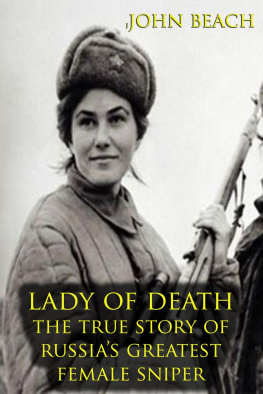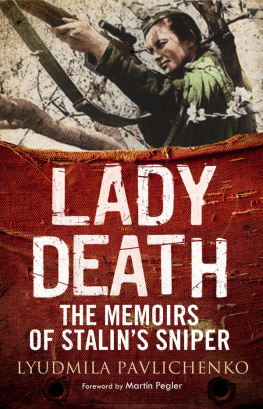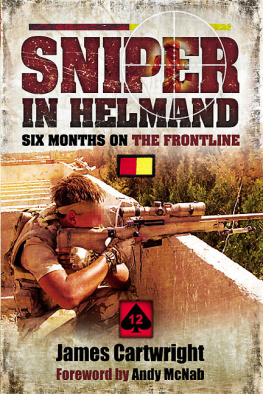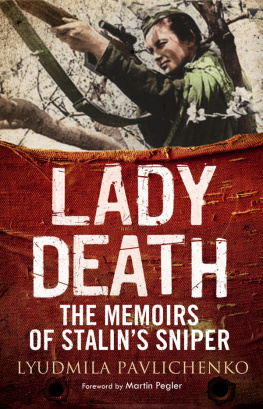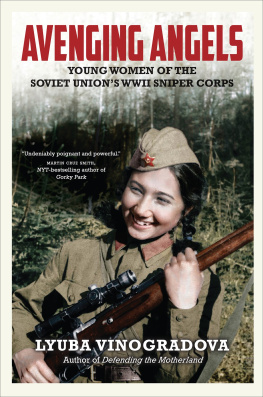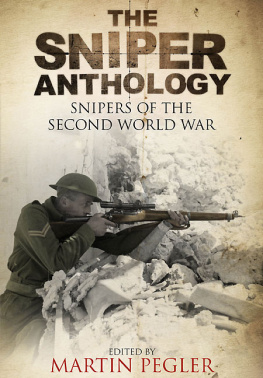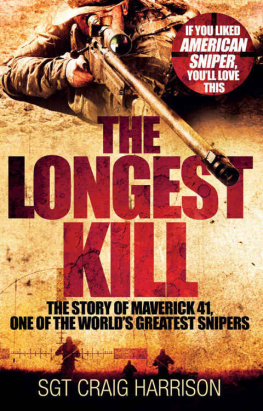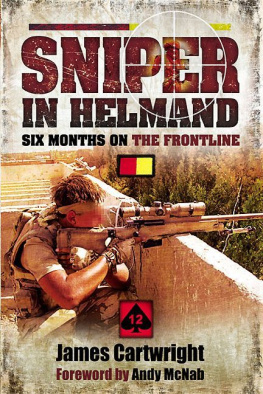LADY OF DEATH : THE TRUE STORY OF RUSSIA'S GREATEST FEMALE SNIPER
JOHN BEACH
I wear my uniform with honor. It has the Order of Lenin on it. It has been covered in blood in battle. It is plain to see that with American women what is important is whether they wear silk underwear under their uniforms. What the uniform stands for, they have yet to learn . - 'Lady Death', Lyudmila Pavlichenko
T he name Lyudmila Mykhiliuna Pavlichenko is a name not often heard when the discussion of great snipers arises. Nicknamed The Lady of Death, Lyudmila was the deadliest female sniper of all time. She was a scourge among the ranks of both Romanian and German soldiers with a kill count of 309.
Despite her modern anonymity, Lyudmila would achieve legendary status with her performance in the Battle of Odessa where she killed numerous enemy officers and soldiers as well as thirty-six Nazi snipers.
This is her story.
EARLY LIFE
Lyudmila was born in the small Ukrainian town of Belaya, Tserkva, near the Polish border on July 12th, 1916. Her family nicknamed her 'Mila' and she dazzled her family and teachers alike with her ability to learn any task quickly and easily. She got high marks during her school years and ranked at the top of her class. Still, life in Belaya was rough and there was no upward mobility for someone of Lyudmila's intelligence. Her family was poor and she was forced into manual labor at the Kiev Arsenal Factory.
The smartest girl in her class was reduced to grinding mortar shells for a living at the age of fourteen. The irony of her situation would not be realized until years later.
The Kiev Arsenal Factory was one of the primary places of employment during those years, Russian historian Vladimir Volkov said. They made anti-aircraft weapons, tanks and whatever type of artillery you can think of.
When the Germans invaded the Soviet Union the factory was moved from its original location in Kiev to the Ural Mountains in order to hide it from the Nazi bombing raids. Mila did not move with the factory and became unemployed.
But she did develop an additional skill while working at the factory. Bored with nothing else to do, Mila joined the Kiev Shooting Club. It was there she learned marksmanship and other Soviet military tactics. Mila loved the training and the shooting. She loved the power she felt in handling a rifle.
"Americans have a hard time understanding how rough the life was in the former Soviet Union," Volkov said. "Mila did not have the luxury of going to ice cream socials and dances when she was a teenager. She was born hard and trained to fight. "
While learning to shoot at the club, Lyudmila first demonstrated her ability with weapons by achieving and winning the Voroshilov Marksman Badge, which was not an easy chore. In order to be awarded the Voroshilov Marksman Badge, each of the usable service weapons had to be mastered and each weapon had its own requirements. A student was trained, and tested, on the use of the pistol, carbine, rifle, and shotgun. A student progressed to a point where the instructor cadre felt that he/she and was competent, at which point the student was tested. If the student scored well enough then the student passed and was awarded for that phase of training. If the student passed the entire course with a high enough score they were awarded the Voroshilov Marksman Award and Sharpshooter award.
The fact that she was accepted into the shooting club and excelled was highly unusual, Vasyl Artemiev said. In the early Soviet Union, it would have been extremely rare to see a woman out in the field taking target practices with the other marksman. For whatever reason, Mila excelled at the endeavor and the Soviet system being what it was, you know, she was put on a track. The Soviet intelligentsia recognized her unique ability and wouldn't squander that despite her gender.
Still, Mila did not join the military until she reached a relatively advanced age of twenty-five. She was finishing her Master's Degree in history when Germany invaded the Soviet Union in what would be called Operation Barbarossa.
"She was a very attractive young woman," Artemiev recalled. "She had many suitors. One of them was a doctor. He wanted her to stay home. He promised her a life of ease and comfort. I tell you about one hundred percent of all women would have taken that deal but Mila refused. She saw the Nazi invasion as duty calling."
THE RED ARMY
Hitler broke the non-aggression pact between his country and the Soviet Union. This betrayal led to an increased patriotism among the Russian people. Mila knew she had to act and help defend her country. Upon word of the invasion, she ceased her studies at the university and joined the Red Army.
The Soviet Army took a look a Mila's resume and thought she would make a great nurse, considering her advanced education. Mila refused. She wanted to be on the front lines.
Mila wouldn't take no for an answer, Artemiev recalled. They offered a nursing job. She said no. They offered her a clerk job and she refused. She wanted to be an infantry soldier. But remember at that time this was unheard of. Women were either nurses or clerks. But she showed the powers that be her certificates in marksmanship. They decided to make Mila the exception and sent her to rifle training.
Mila didn't disappoint. She impressed her instructors with her knowledge of Soviet military tactics, which she had learned while attending the shooting club in Kiev. She impressed them even more with her knowledge and handling of the Mosin-Nagent, .30 cal., 7.62mm, five shot bolt action rifle(vi).This weapon was the Soviet Armys Sniper Rifle and was mounted with a P.E. 4 Power Rifle Scope. This rifle was considered one of the better sniper rifles in use during WW2. But this would not be Mila's weapon of choice. She would use the Tokarev SVT-40 Soviet Assault Rifle.
The SVT-40 is an air-cooled rifle with a 10 round detachable clip and at the beginning of the German invasion was fitted with a scope so as to be used as a sniper rifle. It was later replaced by the Mosin-Nagent as the premier Soviet Armys sniper rifle.
The Mozin-Nagent sniper rifle would be the weapon that Lyudmila would carry after first being issued the Tokarev SVT-40 and getting her first confirmed kills.
Mila took to the rifle like a duck to water, Artemiev recalled. She went to the shooting range and got a perfect score. One hundred bulls-eyes in a row at a range of 550 meters (600 yards).
Mila rose through the ranks fast. Her success led to the Red Army using more than 2,000 women snipers in the war. Only 500 would survive but as a group they would account for over three hundred kills.
Mila's kill count would dwarf all of the female snipers combined, however, as she would kill claim well over three hundred victims.
To be honest, her actual kill count is unknown, Artemiev said. Soviet propaganda inflated the numbers. I've heard numbers as high as five hundred. They were trying to intimidate the Nazi forces. They would hear the numbers and think of Mila as Lady Death, which she was.
It is an interesting side note that not only was Lyudmila not a born Soviet citizen, as noted earlier, she was Ukrainian, and that the Division that she was assigned to was not an original Soviet Red Army Division, but a Russian Army Division. And the history of the Soviet Unions 25th Rifle Division revealed that it was first established as a Russian Army Division during the Russian Civil War (November 1917-October 1922) in 1918 and was originally named the Chapayev Division for it first Russian Commander, Vasily Chapayev. The name was later changed to Red Army's 25th Rifle Division.
On June 24th, the same day that Lyudmila was assigned to the 25th Rifle Division, it's division commander received Stavka Order # 20466.
Next page
